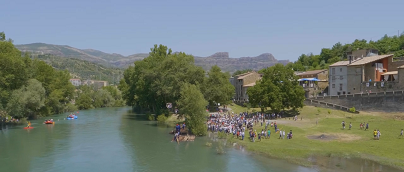
If you prefer to always view the website in English, please click here.
If you prefer to always view the website in English, please click here.
There is evidence to suggest that the species existed during the Neolithic period. The Hermann’s tortoise (Testudo hermanni) also features in Greek mythology, which tells how Hermes made his lyre from the empty shell of this species. The remains found in Pompeii confirm that these reptiles were kept as pets in Roman times and now, in the 21st century, the Testudo hermanni is classified as “endangered”.
Oddly enough, this species has one of the smallest geographical distributions in Western Europe. Within the Iberian Peninsula, Catalonia is the only area in which these tortoises can be found living in the wild… and they are few and far between. Numerous attempts at getting them to develop and reproduce in a certain area have been relatively unsuccessful.
“There are currently more tortoises in captivity than in the wild. Many people keep them in enclosed patios and feed and take care of them for breeding. Therefore, when they are released into an open space, as they are used to being fed and sheltered, the outcome is not favourable. The result is dispersal. They are not able to create a breeding nucleus.” Jesús Almarza is the Technical Director of Trenca, an association dedicated to the defence and conservation of fauna, especially in the region of Les Garrigues (Lleida).
“The Hermann’s tortoise is a species in danger of extinction, hence the need to establish a population that can reproduce in a semi-captive environment”
Jesús Almarza, Technical Director of Trenca
Trenca is responsible for a project aimed at creating a colony of Hermann’s tortoises that can live in this area in a semi-captive environment in which the tortoises can reproduce, and therefore recover the species without having to release the animals on a permanent basis. This project has already been put in motion and Endesa’s involvement is active and ongoing, by financing the work of technical experts in biodiversity conservation. “The first thing Endesa’s experts did was visit the area to define the work required to create the perfect habitat for the tortoises”, recalls Almarza.
This work, which was required in order to create a population of tortoises in a semi-captive environment, was carried out in a group of rural properties, covering an area of around 20 hectares managed by Trenca in Valle Mayor de Bovera (Lleida). Two ponds (400 and 100 square metres, respectively) were built and waterproofed with compacted clay. Fencing systems and double enclosures were also installed in the properties. The idea was to protect them insofar as possible from predators such as boars or foxes, enabling them to live in the wild, although closely monitored.
22 June 2016. In collaboration with CRARC (Catalan Centre for Recovery of Amphibians and Reptiles) and with the assistance of volunteers, since 2016, through the Testudo hermanni project, numerous Hermann’s tortoises have been released. They all had a chip inserted in their shell to identify them, which allows permanent control and supervision to help them in their reintroduction into the habitat. As a result of this monitoring, a minimum survival of 40% of the reintroduced specimens has been detected.
Recently, the maintenance work has continued on the farm as a refuge, and for the monitoring and release of new specimens. On 30 October 2019, with the help of volunteers and with a great social impact, the release of another 30 adult specimens was carried out, provided by the Centre for the Recovery of Amphibians and Reptiles of Catalonia (CRARC), in addition to the 112 released in previous years and to individuals already born in the Bovera reproductive nucleus.
“Our challenge is to work towards preventing the extinction of this species. Campaigning for the recovery of fauna is not new to us; it is our raison d’être”
These details indicate that the project, to date, is being a resounding success; the tortoises have adapted to the environment and have begun to fulfil one of the project’s most important targets: for the population recently reintroduced into the property to become a new reproduction nucleus for this species, which, in time, will enable existing populations of unconnected Mediterranean tortoises to be connected.
The idea is that, as the turtles are laying successfully and fruitfully, the hatchlings can leave the environment to create other populations and, in the future, this experience can even be exported to other parts of Spain.





